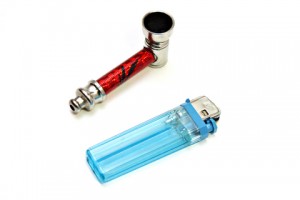
Spice Addiction

Table of Contents
“Spice” is one of several street names for a product that contains synthetic cannabinoids, man-made compounds that mimic the active chemicals in marijuana. Also sold as “incense,” “plant food,” “potpourri” and “K-2,” spice was sold legally in head shops, liquor stores and online until 2011. Although the U.S. Drug Enforcement Administration (DEA) exercised emergency controls over the psychoactive chemicals in spice in 2011, the drug is still widely available through illegal sources, and spice addiction is a growing public concern.
What Is Spice?
Spice consists of dried plant material treated with spices or fragrances and one or more compounds that imitate the effects of cannabis. The product looks like potpourri or incense and has been sold with a warning label stating “Not Intended for Human Consumption” in order to skirt legal regulations. However, users who understand the drug’s potential can smoke the drug or drink it as a tea. Spice can also be mixed with marijuana and smoked. Users take spice for its relaxing, mood-elevating effects, but this product can also cause serious side effects, including:
- Paranoia
- Anxiety
- Hallucinations
- Nausea and vomiting
- High blood pressure
- Elevated heart rate
- Shaking and muscle spasms
- Seizures
The synthetic cannabinoids (or cannabimimetics) in spice affect the same chemical receptors in your brain that respond to marijuana. Like THC, the active compound in cannabis, the chemicals used in spice can cause chemical dependence. With catchy nicknames like “Bliss,” “Genie,” and “Bombay Blue,” spice may not sound like a dangerous drug. Yet spice addiction is just as serious as an addiction to other illicit drugs, and because the long-term effects of spice use are unknown, the need to get help for spice addiction may be even more urgent than you think.
A New Threat to Youth
 Until the DEA made the possession and sale of spice illegal in 2011, the drug was readily available online, in gas stations and through other public retailers. Even after the DEA’s intervention, the use of spice is still a danger to teenagers, who are attracted to its mind-altering effects and find it easy to obtain. In the Monitoring the Future survey of 2011, over 11 percent of high school seniors reported that they had used spice within the past year.
Until the DEA made the possession and sale of spice illegal in 2011, the drug was readily available online, in gas stations and through other public retailers. Even after the DEA’s intervention, the use of spice is still a danger to teenagers, who are attracted to its mind-altering effects and find it easy to obtain. In the Monitoring the Future survey of 2011, over 11 percent of high school seniors reported that they had used spice within the past year.
As a relatively new drug on the streets, spice poses a lot of unknown dangers, especially to young people. Clinical research hasn’t yet confirmed how the chemicals in spice will affect you physically or mentally after months or years of use.
In adolescence, the brain’s impulse control and decision-making capabilities are still developing. Teenagers are notorious risk-takers, and experimenting with drugs or alcohol is common. But teens, parents and educators must all be informed of the potential dangers of synthetic marijuana. When combined with natural cannabis, alcohol, prescription medications or street drugs, spice may be even more dangerous.
- Driving while intoxicated
- Getting into high-risk situations that could lead to falls, burns or drowning
- Having unprotected sex
- Binge drinking
- Getting into altercations with others
Teens who compulsively seek and use spice may have gone beyond substance abuse into the realm of addiction. A rehabilitation facility with a focused program for synthetic drug addiction can help your teenager get back on track. The sooner your teen gets help, the greater the chances of preventing the cognitive and physical damage that spice can cause.
Dangers of Synthetic Cannabis
The American Association of Poison Control Centers (AAPCC) reports that in 2011, 6,959 calls were made to poison control facilities in the US by people who had been exposed to spice. Not all of these calls were made in response to overdoses, but the growing number of reports show that spice use may be more widespread than ever. Most of the spice being sold today is manufactured without any quality control or government regulation, which means that the drug may contain toxins, heavy metal residue or artificial additives that could have unknown effects on the human body.
The addictive potential of spice may be higher than that of marijuana. According to the National Institute on Drug Abuse (NIDA), the compounds in spice may produce an even more powerful response in the brain than natural THC. Addiction is characterized by an uncontrollable urge to use a substance, regardless of your knowledge of its destructive effects. If you’ve been using spice on a regular basis, you may develop an increasing tolerance for the product, followed by a physical or psychological dependence. Once your body and mind rely on spice, getting clean requires professional care, including supervised detox and rehabilitation.
Warning Signs of Spice Addiction
How do you know whether you or someone in your household is actively addicted to synthetic cannabis? You might believe that you’re using the drug strictly for recreational purposes, but if you notice these changes in your personal habits or behavior, you may have an actual chemical dependence:
- You need to use more synthetic cannabis to get the same euphoric effects.
- You feel agitated or irritable when you can’t get access to the drug.
- You continue using spice even though it’s had a negative effect on your relationships, your job or your health.
- You’ve gotten into legal or financial trouble because of spice, but you’re still using the drug.
- You’ve made an earnest attempt to quit using spice, but you’ve failed more than once to remain abstinent.
The Partnership at DrugFree.org adds that these physical symptoms may indicate that someone close to you — a child, a friend, a sibling or a coworker — has been abusing spice:
- Visible agitation or restlessness
- Heavy sweating
- Aggressive or violent outbursts
- Loss of speech/failure to answer questions
- Rapid heart rate
- Delusions or hallucinations
Parents should also be aware of pipes or other drug paraphernalia around the home, packages of potpourri-like substances and discarded plastic packets containing fragments of scented leaves. Physicians, emergency services providers and addiction specialists are still learning how to respond to the effects of spice. If you notice a sudden change in behavior or health condition in yourself or a loved one and there’s a chance that synthetic drugs are involved, seek medical attention immediately.
Rehab and Recovery
 Spice may be a novelty in the world of illicit drugs, but it’s already caught the attention of addiction professionals as a danger to public health. A treatment plan for spice addiction may begin with detox and progress to rehabilitation and recovery. In detox, you’ll receive a medical evaluation to determine the effects of the synthetic cannabis on your physical health and mental status. As the drug leaves your system, counseling sessions and group therapy can provide the support you need to establish a new, sober life.
Spice may be a novelty in the world of illicit drugs, but it’s already caught the attention of addiction professionals as a danger to public health. A treatment plan for spice addiction may begin with detox and progress to rehabilitation and recovery. In detox, you’ll receive a medical evaluation to determine the effects of the synthetic cannabis on your physical health and mental status. As the drug leaves your system, counseling sessions and group therapy can provide the support you need to establish a new, sober life.
Many people who develop an addiction to spice also have co-occurring addictions. You may also need treatment for alcohol addiction, prescription medication abuse, marijuana abuse or cocaine dependence. A comprehensive treatment program addresses all aspects of your addictive behavior, including any underlying mental health disorders, such as depression or bipolar disorder, that may contribute to your substance abuse.
The dangers of synthetic cannabis still aren’t completely known, but the benefits of rehab and recovery from drug addiction are clear. Leading a healthy, stable life can bring you a sense of satisfaction, pride and personal integrity. Sobriety can strengthen your relationships, improve your career outlook, and help you avoid the health complications of drug and alcohol abuse. Get in touch with one of our addiction specialists here at Axis to find out how our treatment programs can help you or a loved one begin the stages of recovery.






